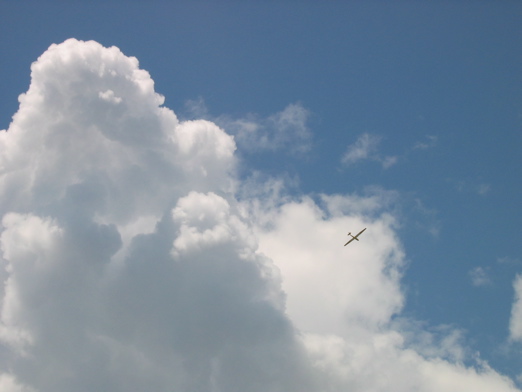Cristy and William had an opportunity to take rides in a glider and write about the experience, the art of gliding and the Illini Glider Club. While William, whose father is a pilot, grew up riding in small airplanes and had been in a glider before, Cristy's closest experience to gliding was falling off her childhood swingset. What follows is their experiences.
William: The Illini Glider Club sits on the outskirts of Monticello: a grassy airstrip, a hangar filled with five gliders and a tow plane, a couple of folding chairs and an ocean of sky. Only some distant trees and a few rusted barns intrude on this vista.
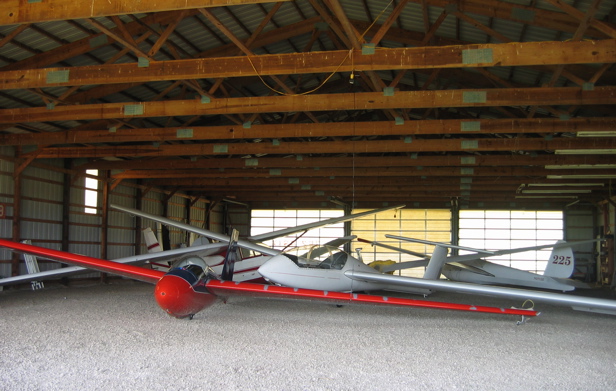
The day we visited to take a ride, a morning shower had just blown over, and the sky was piled high with ivory cumulonimbus — a good sign for gliders.
Cristy: When William asked me if I wanted to go gliding, I hesitated. Did glider mean hangglider? I laughed nervously, not really saying yes or no. When William tried to reassure me that a glider was enclosed, I broke into a panicky, cold sweat. Immediate thoughts of nosediving into a field flooded my mind.
W: A glider is a small airplane with no engine. It is pulled into the sky by being towed behind a car or plane. The glider pilot then coasts back to Earth. While the pull of gravity cannot be resisted, glider pilots can exploit updrafts, or thermals — bubbles of rising air — such that the speed of their descent through the air is matched or exceeded by the speed at which the air is rising. It is possible to stay aloft for quite some time. The updrafts can sometimes be found under cumulonimbus clouds, or above certain topographic features, but their behavior is no more predictable than the weather. An experienced glider pilot develops a sixth sense for discovering thermals, and with luck can stay aloft for hours.
Although typical Glider Club flights return to the airstrip from which they took off, the real challenge for dogged glider pilots is cross-country travel, where you hop from updraft to updraft and try to cover some serious distance, always remaining cognizant of where all the small private or commercial airstrips are because you never know when you'll run out of thermals and have to land. Then you need a crew who can come pick you up — either taking your glider apart and putting it on a truck, or flying a tow plane out to where you have landed and pulling you home.
Distance flown, altitude gained, and duration of time aloft are three measurements of accomplishment for glider pilots. In 1966, the club's incredible year of drought-induced thermals, club member William Rogers flew a 311-mile, seven-hour flight, landing in Paragould, Ark. In December of that year, Stew Stoddart, flying an oxygen-equipped glider near Pike's Peak, Colo., flew to 28,000 feet. (Current world gliding records can be found on the Soaring Society of America web site.)
For our glider ride, our pilot is 20-year club member Robert Gillespie, a retired economics professor, a Navy pilot who reached the rank of Captain and my father. He flew for the Navy in the Korean War and describes his activities as such: "My squadron was land-based and the mission was maritime patrol. We were interested in finding anything on the surface of the ocean or under the surface of the ocean. Also, when close to 'hostile' territory we would go in close enough to present a radar target. The [enemy] search radar operators would then lock on to us. This gave us the opportunity we needed to capture their radar fingerprint and get a line of bearing. After several lines of bearing we could locate the position of the radar transmitter."
C: After a few days of worrying (and updating my will), I decided to stop being a wimp and go for it. Once I said yes, I became wholly enthusiastic. I was going to do something amazingly cool—and make a good impression on William’s dad.
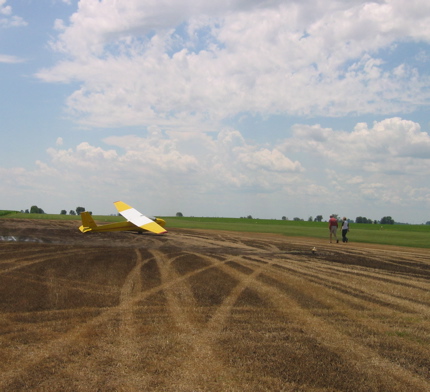
The glider is a two-seater and can take only one passenger at a time. With my new, sassy attitude, I ride first. As Bob and I walk toward the small plane, he turns to me and asks, “Do you get motion sickness?”
“Oh, no. I’ll be fine!” I exclaim loudly. I will come to regret that statement.
I heave myself into the glider behind Bob. The space is tiny, reminding me of a cramped ride at the state fair. I barely have room to move my arms or legs. (NOTE: Don’t glide if you’re claustrophobic.)
Bob’s fellow club member, Illini Glider Club President David Pontius, straps me in. My heart beats wildly. I can’t wait to tell my parents, my grandparents, my friends, my work colleagues — even my cat.
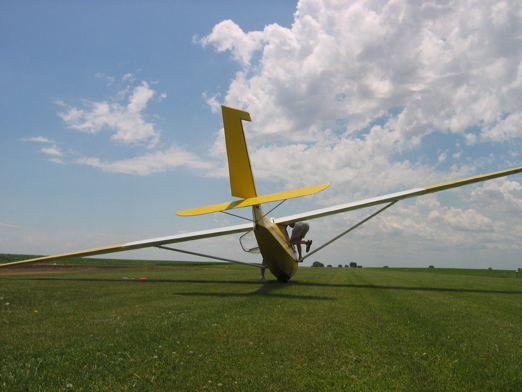
W: My dad is a pilot's pilot — it's in his blood. You can tell by the way he drives. He keeps meticulous logs of every mile and has never been responsible for a traffic accident. Family roadtrips observed a strict protocol in which the person occupying the passenger seat was deemed navigator.At age 78, he is considering hanging up his wings for good after the gliding season ends this year. It seems as though this will be one of our last flights. I am strapped into the back of a tiny glider with about as much legroom as I’d get on a tricycle. The tow plane taxis down the runway dragging us behind it and as we lift off (the glider will leave the ground before the heavier tow plane), I immediately understand I am in for a much more raw flight experience than I would get on a passenger jet. The glider shakes during takeoff as it is dragged and buffeted by side winds. There's no air-conditioning, no oxygen masks, no drinks, no padding on the wooden seat. Air whistles through the fiberglass hull and my arm is pressed against a door that is held shut by a thin wire that seems improvised. The plexiglass canopy is inches from my head — I can see straight down on either side.
C: Adrenaline courses through my veins. As we ascend, I think, I’m powerful...I’m courageous...I’m…freaking…nauseated. I can’t believe how swiftly the airsickness strikes.
Mind over matter, I think, trying the mental exercises I learned in yoga class. Think good thoughts. Think about how amazing this opportunity is. And it is an amazing opportunity for adventure. In Colorado, you can climb mountains, in California you can surf. In the plains of Illinois, where else other than gliding can you have an exhilarating experience?
We hit 4000 feet and the tow plane lets us go with a jerk. Clenching my jaw, I sit, lightheaded and clammy, as Bob points out landmarks. I hum the Who’s “I Can See For Miles.” I marvel at the agricultural land grids and the tiny cars that crawl along the interstate cloverleaf formations like insignificant ants on a sidewalk. Then I throw up. Three times. So much for good impressions.
W: As the horizon drops around a surprisingly colorful patchwork of farmland, I manage to drop my acrophobia and lose the sense of being on a seedy carnival ride. Different crops have different hues, and the green is mottled by swirls of brown dirt where corn has been killed by flooding in this rainy season.
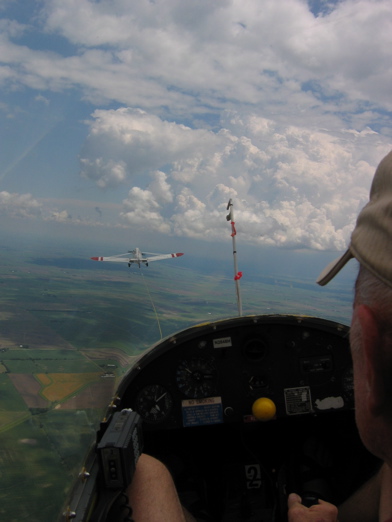
Up ahead, over the pilot’s shoulder I can see the tow plane and the rope connecting us. When the moment comes for the glider pilot to pull the level to release the rope, there is a scary lurch, and then the soaring becomes smooth. We fly at an airspeed of 55 miles per hour and begin our descent from 4800 feet.
This is raw aerodynamics, without propulsion. The flying experience is a pure negotiation of gravity and air pressure, as close as we will come to being birds.
Without an engine, the glider can seem quiet compared to the experience of riding in a small plane. But in this 50-year-old aircraft (a Schweizer 2-33), the absent roar of the props is filled in by the whistling of wind in the cracks. The pilot and I must shout to hear each other, though our heads are less than two feet apart. We're high enough for our ears to pop.
I see a swatch of forested land that I identify as Allerton Park. A muddy Sangamon river snakes through it. The pilot points out a rectangular clearing that is the grassy lawn of Allerton House, and a circular clearing where the Sunsinger statue stands. Monticello isn’t much, and from 3800 feet it looks like even less: I can see the entire town. All that can be seen of Champaign-Urbana is the white sliver of the Assembly Hall in the east. I am able to identify the airstrip of the glider club, where we will soon land. It looks like just another rectangle, another shade of green.
The landing is the most frightening part, when the ground is hurtling toward you, with no in-flight magazine to distract you. The contact with the unpaved runway is indeed a bit rough. But the Illini Glider Club — in its 48-year existence — has had few mishaps and no casualties.
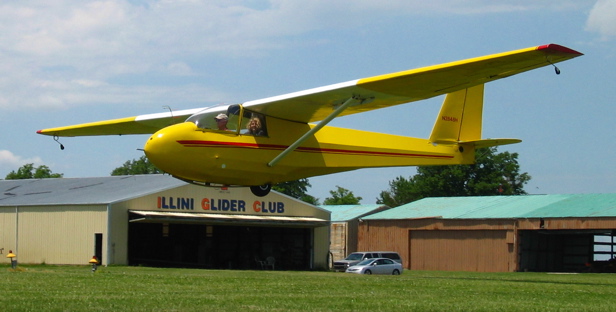
C: The landing is the scariest part? I don’t think so. I was never so relieved as when we hit the grass and come to a jostling, rapid halt.
I sheepishly admit to Bob and David that I got sick during the flight. Mortified, I climb out of the glider with breakfast all over my left pant leg. “You’re not the first one to get airsick,” David laughs.
When he sees me emerge from the plane, William runs over to give me a hug, but stops short at the sight of my pants and green pallor.
“That’s okay,” he says, backing away from me, “You don’t have to hug me.”
W: When my father joined, the club was a University of Illinois student organization in Willard airport with a car that could drag the gliders to 500 feet or so. When I was a kid, he was co-owner of a small plane (a single engine Mooney), but he says that as a recreational pilot he prefers gliding because of the challenge. Learning to glide can be the first step toward becoming a pilot, and perhaps the most important one. After all, says Captain Gillespie, one of your first worries as a pilot is what to do if the engine quits. When that happens, what you are left with is a poorly-performing glider. Having gliding experience gives you the confidence you need to handle that situation — the basic experience of using your wings.
Illini Glider Club membership goes up and down with the transient student population. Finding enough instructors is a big challenge, and the club tries not to take on more members than it can serve. There is a waiting list. But they do offer rides to walk-ins for a fee. They lease the airstrip from a farmer and it's an arrangement that might end someday, but the club seems as though it will survive. It’s stayed in the air for almost half a century and I expect it will continue to find updrafts when it needs them.
